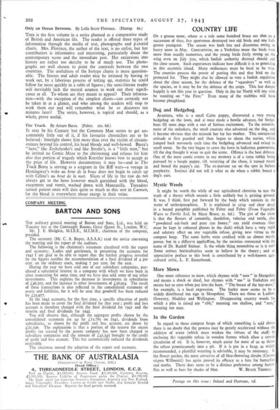COUNTRY LIFE
ON a grouse moor, where as a rule some hundred brace are shot on a succession of days, five sportsmen destroyed two old birds and one half- grown youngster. The season was both late and disastrous owing to heavy snow in May. Contrariwise, on a Yorkshire moor the birds were more than usually numerous, and the young birds fairly strong on the wing even on July 31st, which foolish authority decreed should end the close season. Such experiences indicate how difficult it is to generalise in this eccentric island. Many ordinances must be local to be wise. The counties possess the power of putting this and that bird on the protected list. They might also be allowed to veto a foolish regulation about the close season, for the defence of the " squeakers " as well as the species, or it may be for the defence of the crops. This last danger happily is not this year in question. Only in the tar North will any corn be standing on " the First." Even many of the stubbles will have become ploughland.
Dog and Hedgehog Araminta, who is a small Cairn puppy, discovered a very young hedgehog on the lawn, and at once made a hostile advance, for hedge- hogs fill most dogs with a sort of furious excitement. To the astonish- ment of the onlookers, the small creature also advanced on the dog, and it became obvious that she mistook her for her mother. This unexpected attitude at first puzzled and then began to alarm the terrier, which jumped back nervously each time the hedgehog advanced and raised its small snout. So the two began to cross the lawn in ludicrous pantomime, till the dog thought it wiser to quit the scene. Offence is the best defence. One of the most comic events in my memory is of a tame rabbit being pursued by a beagle puppy, till, wearying of the chase, it turned round and boxed the puppy's ear. The ex-pursuer sat on the spot in forlorn perplexity. Instinct did not tell it what to do when a rabbit boxed a dog's ears.
Mystic Weeds It might be worth the while of our agricultural chemists to test the truth of a theory which sounds a little unlikely but is gaining ground. It was, I think, first put forward by the body which rejoices in the name of anthroposophists. It is explained in crisp and clear detail in a bound pamphlet published by Faber and Faber (From Vegetable Waste to Fertile Soil, by Maye Bruce, 2s. 6d.). The gist of the claim is that the flowers of camomile, dandelion, valerian and nettle, plus " powdered oak-bark and pure run honey," can yield essences (they must be kept in coloured glasses in the dark) which have a very rapid and salutary effect on any vegetable refuse, giving new virtue to the compost heap. The same herbs were credited with an almost mystic power, but in a differe-it applic-dtion, by the societies connected with the name of Dr. Rudolf Steiner. Is the whole thing moonshine or is it not Some serious horticulturists seem to believe in the theory ; and an appreciative preface to this book is contributed by a well-known agri- cultural critic, L. F. Easterbrook.
More Mows One more reference to mow, which rhymes with " now " in Shropshire and means a shock or sheaf, but rhymes with " too " in Yorkshire and means hay or corn when put into the barn. " The breast of the hay-mow," for example, is a local expression. The barley mow seems to be a widely distributed inn sign in Shropshire. There are those at Ludlow, Oswestry, Madeley and Wellington. Disappearing country words fot which a plea is raised are " ebb," meaning too shallow, and " cern," meaning too near.
In -the Garden In regard to those compost heaps of which something is said above, there is no doubt that the process may be greatly accelerated without the addition of water (which must weaken the virtues of the stuff) by enclosing the vegetable refuse in wooden frames which allow a certain circulation of air. It is, however, much easier for most of us to throw the refuse promiscuously into a pit. If it is put in a heap, as widely recommended, a plentiful watering is advisable, it may be necessary. In the flower garden, the most attractive of all blue-flowering shrubs (Ceram- stigma Willmottii) has again proved, its efficacy as a lure for butterflies and moths. There does seem to be a distinct preference among butter-
flies as well as bees for shades of blue. W. BEACH THOMAS.
Postage on this issue : Inland and Overseas, rd.






















 Previous page
Previous page